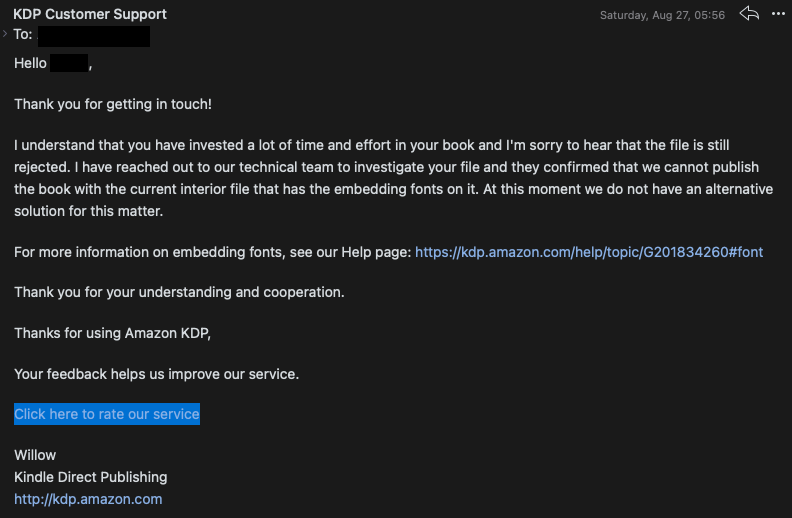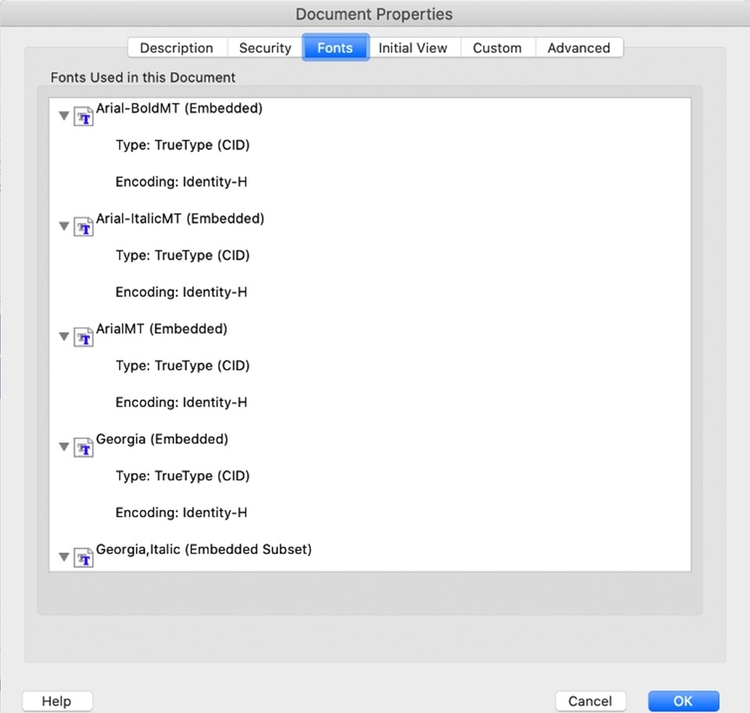- Home
- InDesign
- Discussions
- Re: Amazon Kindle Direct Publishing (KDP) rejects ...
- Re: Amazon Kindle Direct Publishing (KDP) rejects ...
Copy link to clipboard
Copied
My design studio designed and formatted a book for a self-published author using InDesign and two fonts, one being an Adobe Font (Linux Libertine and Aaux Next). We provided the author with a print PDF in CMYK to upload. We have an active Adobe Cloud subscription for anyone using the files. We've designed and had dozens of books printed and never ran into this issue Amadon Kindle Direct Publishing (KDP) presented
The author has spent the last several weeks going back and forth with KDP support about the proper file format they need and the Adobe Font used. KDP support told the author they couldn't print his book because KDP doesn't hold the license to the Adobe Font. 😡
Amazon KDP support responses seem to contradict Adobe documentation on font licensing for printed books unless they're considered a print bureau. Even if they are that, we didn't provide packaged files so that wouldn't apply to this situation right?
https://helpx.adobe.com/fonts/using/font-licensing.html#act-comm
https://helpx.adobe.com/fonts/using/font-licensing.html#act-pdf
1. Amazon KDP claims that fonts that say "Embedded Subset" aren't actually embedded and may not print correctly. In Acrobat when viewing the Properties > Fonts panel, all fonts show as "Embedded Subset".
https://www.adobe.com/uk/acrobat/resources/embed-fonts-in-pdf.html
2. Amazon KDP claims they are a print bureau and referenced this page: https://helpx.adobe.com/fonts/using/package-font-files.html. They claim they must have the license to the Adobe Fonts to print the book. We did not provide packaged files from InDesign. Only a PDF.
3. Amazon KDP mentioned the PDF x/1-a format and a flattened file. We provide a file in that format.
In Acrobat we used the Print Production Tool > Flattener Preview to convert all text to outlines using the '100' setting for raster. Is changing that to 0 so all text is converted the only way to use a custom font with Amazon KDP? Rasterizing the entire book? It is just black text on the interior and very few images, but still, it seems ridiculous to have to do that.
Has anyone else run into this issue with Amazon KDP for a print version of a book? This book is scheduled to release later this month and right now won't print with the custom fonts.
The author gave up and changed the fonts (every designer's nightmare) instead of attempting to use a fully rasterized PDF made from Acrobat with the raster setting on '0'
I also love KDP's resources that all reference how to use MS Word to format your book... 🙄
Help!
 2 Correct answers
2 Correct answers
To start with, KDP is almost impossible to resolve problems with. You fly through the keyhole, or you don't get past the door. Knocking will do no good. All you will get, in nine responses out of ten, is an AI-generated cloud of fog that something isn't good enough. And KDP documentation ranges from the six-pages-on-one-trivial-point to two paragraphs summarizing a complex procedure to links that no longer go anywhere to clear, concise and detailed guidance that is five years out of date.
If t
...SOLVED!
Just a little update: My book is a coloured paperback (not Kindle). I finally embedded all the fonts, which was a big fat faff! I unchecked ‘ligatures’ in the character panel for all paragraph styles and the master pages. Also, PDFs saved from Illustrator and imported into InDesign brought in the fonts too, so I outlined them for ease.
KDP’s ‘dense vector graphics’ flag was silly. Even underlined text with colour is considered a vector! I didn’t change much as that’s the design.
When expo
Copy link to clipboard
Copied
Hi James,
Thanks for the reply. Here is what the KDP live chat lady (or bot, who knows!) said:
"Interior contains dense, vector graphics and unembedded fonts Poppins-Light-Identity-H (242x on pages 4...86), Poppins-SemiBold-Identity-H (22x on pages 10...83), Poppins-Bold-Identity-H (11x on pages 14,22,28,39,43-46,51,73,78). Suggest the publisher returns to their native manuscript editor, ensures all fonts are fully embedded with commercially licensed versions of the fonts, or are outlined to reduce the need for font mapping. Additionally, the publisher will need to rasterize all vector graphics to single, raster images. After taking the preceding actions, the publisher will need to generate a new Print Ready PDF (https://kdp.amazon.com/en_US/help/topic/G202145060)"
I have looked at the PDF in Arobat, and all the fonts have (Embedded Subset) after them. They are Adobe fonts that I use within Indesign (I have a CC subscription). As for the vectors, they are imported from Adobe Illustrator and are far from complex (illustrations of a few flowers)!
I received an email this morning stating the above error, then further down in the email it says:
"Asset that meets guidelines: Cover
Please do not submit proof requests until file corrections have been made and we’ve removed the hold.
Your interior file meets our submission requirements; it's not necessary for you to make any revisions to this file or upload it again."
Contradiction or what!? I have been in touch with the live chat agent, and they said they will try and wave the error message on the file. Absolute madness!
Copy link to clipboard
Copied
Just to pile on, KDP is 95% bots and about 4.8% human staff that is, from all evidence, both ESL and working from a rigid playbook. Communication is extremely difficult and answers outside the bot-generated errors and (often outdated and incomprehensible) playbook/interaction guide are not seen.
But yes, the above is contradictory and meaningless gibberish. The trick, as always, is to find out what's really causing the problem and fix it. (That is, your car might overheat for five different reasons; just because your onboard system says your coolant is low may or may not be any factor.)
The extremely odd specificity (that the font fault is on page 11, for example) indicates to me that the real problem lies elsewhere. Something is tripping a bot's rules, but what's being reported is collateral or coincidental or just plain secondary.
It's not really possible to do more than guess at fixes without seeing the source, which I don't know if you're willing to share (even privately). But one thing you might try is to NOT subset fonts; that's a very reasonable practice, but in a PDF for a destination as fussy as KDP there might be, say, stray or hidden characters whose glyphs are omitted, triggering the "not embedded" or "not licensed" warnings.
And even simple graphics out of AI can be... too complicated for print export, with too many layers, wrong color modes, transparency issues etc. Everything you place in a project for export to PDF for print should be the simplest, most-reduced form to avoid these secondary issues. (You don't say whether this is B+W or color, either — color, of course, adds more problems.)
Copy link to clipboard
Copied
SOLVED!
Just a little update: My book is a coloured paperback (not Kindle). I finally embedded all the fonts, which was a big fat faff! I unchecked ‘ligatures’ in the character panel for all paragraph styles and the master pages. Also, PDFs saved from Illustrator and imported into InDesign brought in the fonts too, so I outlined them for ease.
KDP’s ‘dense vector graphics’ flag was silly. Even underlined text with colour is considered a vector! I didn’t change much as that’s the design.
When exporting the PDF, KDP prefers the preset ‘PDF/X-1a:2001’ (I’ve never used this setting before). Then, under ‘Advanced', ‘Subset fonts when percent of characters used is less than..' and change it to 0%. By doing all of the above actually massively reduced my PDF file size.
To check fonts are embedded and the print file is good to go, open the print-ready PDF in Acrobat. Go to File, Document Properties, Fonts. They should all say Embedded. Then, go to Print Production under Tools (on the left hand side for me - I’m using a Mac) and click Preflight to analyse. It should say ’no errors’! FINALLY!
I resubmitted my manuscript, and the book is live again. I spent a stressful day trying to figure this out with the help of my mate, Chat GPT. I’d be thrilled if my struggles help even just one other person. Good luck!
Copy link to clipboard
Copied
This is pretty much the usual "flip switches until the car starts" approach KDP requires. Consistency between instances is... not assured. But glad you found a way through the tangle.
FWIW, I don't think I've ever had a PDF rejected by the KDP print process for technical reasons — which is not the same as the occasional layout or size error — and I've never paid close or Expert™ attention to the PDF settings or characteristics. I think it takes compound errors (== format, conversion and export settings) to create a snarl, and those aren't always resolved by the simplicity of a designated PDF standard.
Copy link to clipboard
Copied
Also just to note, I have found there is sometimes an issue (especially for body fonts) from Adobe Fonts; if they are originally from Google, unsync them from Creative Cloud and download from Google directly.
Copy link to clipboard
Copied
Um... Adobe Fonts =/= Google Fonts =/= foundry fonts =/= fonts from AMillionFreeFonts.com etc.
Having a mixed set of fonts causes all kinds of problems with almost every kind of digital export; they are suitable only for dumping from one system to a local printer, and sometimes not even then. If you're intent on export for third-party use, such as Kindle and KDP print, you really need a purged/purified/up to date font library as a foundational step.
I'll just note there were several key technical issues you didn't mention until these "solutions." Hard to guess what to ask or suggest if we don't know, say, (1) it's for print; (2) it's in color and (3) you've evolved through a series of font sources. 🙂
Copy link to clipboard
Copied
I am glad you found the solution to your problem, but it's a bit weird to piggyback on a similar but not the same issue and mark your answer as solved, when my (OP) problem was not solved.
You didn't provide any details on which Preflight tests you ran either.
Did your fonts say Embedded or Embedded subset?
How did you embed them differently than using an Adobe Font?
Maybe those items among might help others with the same issue.
Copy link to clipboard
Copied
We weren't able to figure out how to use the Adobe Fonts for the Kindle version. Our client opted to switch to some system fonts which were approved. KDP's reasoning for rejecting and unclear details is exatly as @James Gifford—NitroPress describes.
Starting with the specific error or rejection message is best and reviewing James' notes about any glyphs or off page text boxes that might have an incompatible font being used.
Copy link to clipboard
Copied
The solution here is to not spec or embed fonts in Kindle (or EPUB). E-book design should be done around generic font types that can, and will, be set by the actual reader (app or software); to try and force these systems to use specific fonts simply bloats the file sizes and creates endless headaches from initial technical issues to fighting every user on his or her choices.
-
- 1
- 2
Find more inspiration, events, and resources on the new Adobe Community
Explore Now





